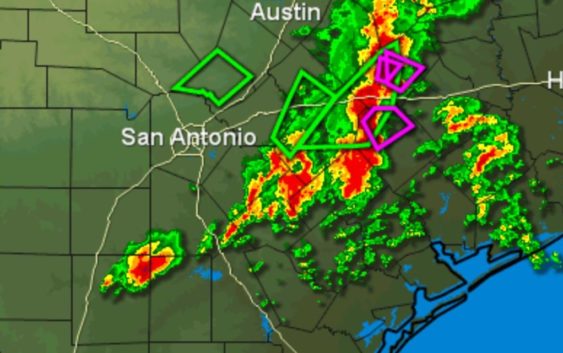- After Hurricane Beryl, Texas lawmakers push for generators at senior living facilities
- 20-million-gallon detention basin in Meyerland designed to help prevent flooding
- Firefighters report significant progress on McDowell County wildfire
- How to watch the FireAid benefit concert for LA wildfire relief
- FireAid, a benefit for LA wildfire relief, is almost here. Here’s how to watch and donate
KENS 5 Weather: Tornado Watch lifted for Bexar, Comal county, but severe storms continue east of San Antonio

Follow KENS 5 on air and online for breaking severe weather coverage. Get the KENS 5 app for alerts when severe weather threatens South Texas.
SAN ANTONIO — The National Weather Service has removed Bexar County from its Tornado Watch, but many other counties along the I-35 corridor and eastward remain under a threat of severe weather Tuesday night.
A tornado watch means conditions are favorable for tornado development. Several Tornado Warnings are active far east of Bexar County, including a confirmed tornado that was spotted in Fayette County around 6:55 p.m. A Tornado Warning is in effect for the county until 7:45 p.m.
Lavaca County east was under a Tornado Warning, which expired at 5:10 p.m.
A Severe Thunderstorm Warning for the Gonzales County area stretching into western portions of Lavaca and Fayette expired as of 5:45 p.m. That area is now under a Flash Flood Warning until 8:30 p.m.
At 4:50 p.m., significant tree damage along with barn damage has been reported around Sublime in Lavaca County.
A Flash Flood Warning was in effect for northern portions of Comal County, including Bulverde, Canyon Lake, Fischer, and Spring Branch until 7 p.m. Tuesday night. A Severe Thunderstorm Warning for the area expired as of 3:45 p.m.
The Flash Flood Watch will be in effect until Thursday afternoon.
With several rounds of showers and thunderstorms over the next seven days, South Texas could receive an additional 3” to 5” of rain.
Flash flooding may occur in some communities due to saturated soil from recent rainfall.
This is a developing weather event. Refresh the page for the latest updates.
SEVERE WEATHER 101
When severe weather threatens the area, it is important to know what risks a storm can bring and what you should do to stay safe.
One of the most important things to know is where you are located on a map, so when a watch or warning is put into place, you can identify if you are at risk. When the National Weather Service puts out warnings, they are county-based and sometimes include cities as well. It is important to know where you live in the county and that you can identify it on a map.
It is also important to know the difference between a watch and a warning. A watch means that conditions are favorable for something to happen, but a warning means that something has developed and it is important to take action.
So, what would cause a thunderstorm to be qualified as a “severe” thunderstorm?
Hail that is one inch large is also considered to be about the size of a quarter.
Another ingredient that would lead to a storm becoming severe is if winds are 58 mph or greater.
Winds at this strength could cause damage to roofs and could even cause trees to be knocked down.
Finally, if a tornado is present inside a thunderstorm it would qualify the storm as becoming severe.
In this instance, a tornado warning would be issued.
A tornado watch can be issued for an area if strong storms are expected, and if the storms bring the risk for tornadoes, but not all storms include the threat for tornadoes. The ingredients in the atmosphere for a tornado to form are not always there when storms are present.
If the area you are in is ever under a tornado warning, it is important to know where you should go inside your home.
Head to the lowest, interior room of your home. The basement would be best, but if you don’t have one, head to the first floor of the home and get away from exterior walls, or walls that lead to the outside of the home.
It is also important to stay away from glass. The more walls you can put between you and the outside, the better.
While lightning can be frequent in storms and very dangerous, it does not lead to a storm being qualified as severe.
Remember, when thunder roars, go indoors.
Storms can also lead to flooding. Flooding may not cause a storm to be labeled as being severe, but it is the deadliest kind of weather.
South Texas is known to have major flood events every few years, so it is important to use caution and to always stay out of floodwaters. Remember, turn around, don’t drown.
Entering flood water is very dangerous as you can be swept off of your feet and you don’t know what could be in the water that could hurt you.
The best thing you can do to be ready for severe weather is know what you will do in the event it strikes where you live.
Make sure your family has a severe weather action plan.
Have a place everyone goes inside your home and keep supplies there, such as food, medication, batteries, and flashlights.
Weather Minds Classroom: Take a class in Severe Weather 101
Follow the KENS 5 Weather Team
Don’t forget you can download the KENS 5 app for the latest news and weather information each day while you are on the go.